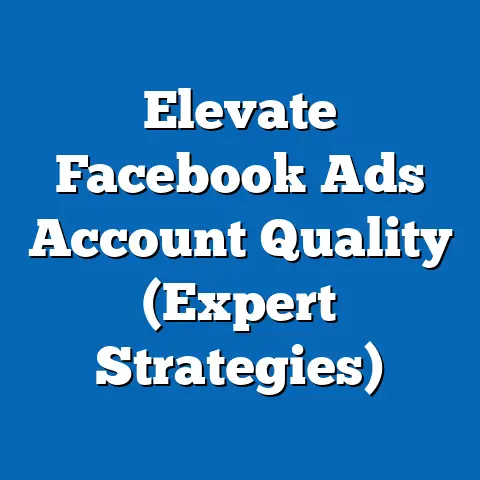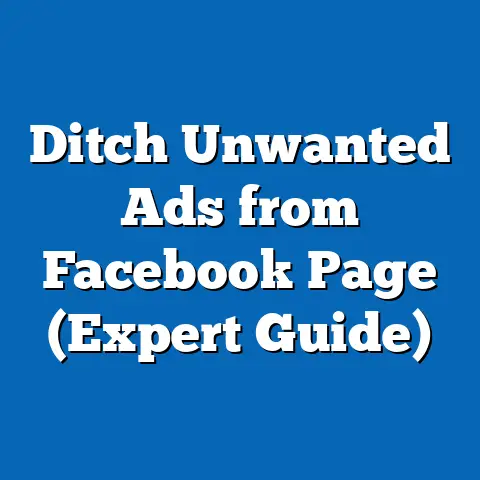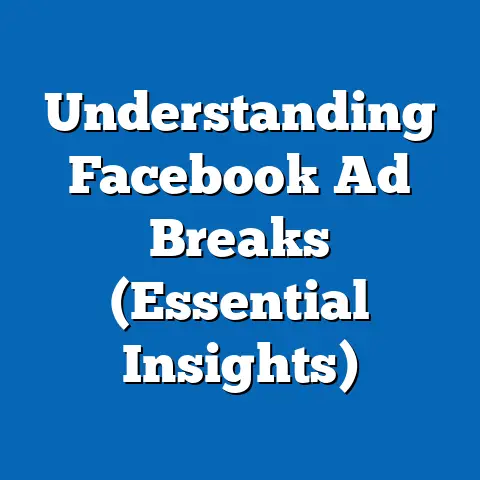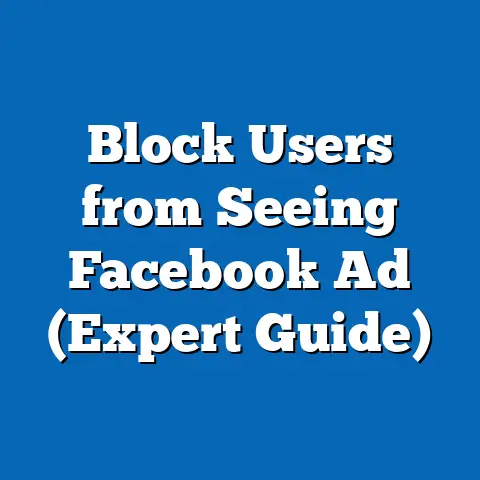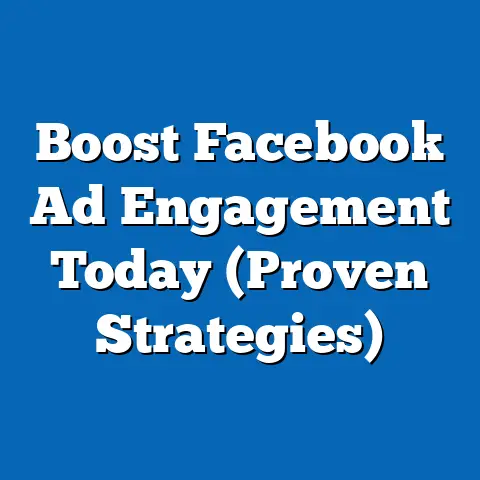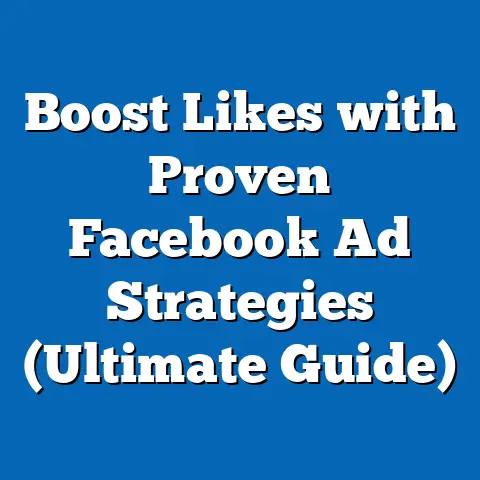Mastering fb ad Visibility (Proven Strategies Revealed)
Have you ever felt like you’re shouting into a void? That’s exactly how I felt when I first started experimenting with Facebook ads. I remember pouring hours into crafting what I thought was the perfect campaign. I had a killer product, a beautifully designed ad, and a budget I thought was reasonable. I hit “publish” with a surge of excitement, picturing the sales rolling in.
But then… crickets.
My ad was live, sure, but it felt like it was hiding in the digital shadows. Engagement was dismal, costs were high, and I felt like I was throwing money into a black hole. It was frustrating, to say the least. That’s when I realized that simply having a great product and a well-designed ad wasn’t enough. I needed to master visibility. I needed to make my ads seen. That realization sparked a deep dive into understanding how Facebook’s algorithm works, what strategies truly boost visibility, and how to measure success. It wasn’t an overnight transformation, but it was a crucial turning point. Now, I’m excited to share with you the proven strategies I’ve learned along the way, so you can avoid the pitfalls I stumbled into and make your Facebook ads truly shine.
Understanding Facebook Ad Visibility
In the world of Facebook advertising, visibility isn’t just about being seen; it’s about being noticed by the right people, at the right time, with the right message. Think of it as the digital equivalent of prime real estate. You can have the best store in town, but if it’s tucked away in a back alley, nobody will find it. Similarly, your amazing ad will fall flat if it’s not reaching your target audience.
Several factors influence your ad’s visibility. These include:
- Audience Targeting: Are you reaching the people most likely to be interested in your product or service?
- Ad Placement: Where is your ad appearing on Facebook and its network?
- Competition: How many other advertisers are vying for the same audience and ad space?
- Ad Quality: Is your ad engaging and relevant to your audience?
Why is visibility so important? Because it directly impacts your campaign’s success. Higher visibility leads to:
- Increased Click-Through Rates (CTR): More people seeing your ad means more people clicking on it.
- Higher Conversion Rates: When the right people see your ad, they’re more likely to take the desired action, whether it’s making a purchase, signing up for a newsletter, or downloading an app.
- Lower Costs: Facebook’s algorithm rewards ads that are engaging and relevant, which means you can often achieve better results at a lower cost when your visibility is high.
According to recent data, ads with high visibility enjoy up to a 3x higher CTR compared to those with low visibility. This translates directly into more traffic, leads, and sales.
But how does Facebook’s algorithm determine ad visibility? It’s a complex system, but at its core, it aims to deliver the most relevant and engaging content to each user. The algorithm considers factors like:
- Ad Relevance Score: This measures how well your ad resonates with your target audience.
- Bid Amount: How much you’re willing to pay for your ad to be shown.
- Estimated Action Rate: Facebook’s prediction of how likely users are to engage with your ad.
- Ad Quality: The overall quality and appeal of your ad creative and copy.
By understanding these factors, you can begin to optimize your campaigns for maximum visibility and achieve the results you’re looking for.
Takeaway: Visibility is the foundation of successful Facebook advertising. By understanding the factors that influence visibility and how Facebook’s algorithm works, you can begin to optimize your campaigns for maximum impact.
Proven Strategies for Enhancing Visibility
Okay, now for the good stuff! Let’s dive into the specific strategies I’ve used to boost the visibility of my Facebook ads and achieve impressive results.
Target Audience Precision
Knowing your target audience isn’t just a good idea; it’s absolutely essential for Facebook ad success. I’ve seen firsthand how a well-defined target audience can transform a struggling campaign into a high-performing one.
Think of it this way: you wouldn’t try to sell snow shovels in Miami, right? Similarly, you shouldn’t be showing your ads to people who have no interest in your product or service.
Facebook offers a powerful tool called Audience Insights that can help you gather valuable data about your potential customers. This tool allows you to analyze demographics, interests, behaviors, and even purchase habits of people on Facebook.
Here’s how I use Audience Insights:
- Start with a broad audience: Initially, I’ll input some basic demographics, like age, gender, and location, based on my initial understanding of my target customer.
- Explore interests: I’ll then start exploring different interests related to my product or service. For example, if I’m selling fitness apparel, I might explore interests like “yoga,” “running,” “weightlifting,” and “healthy eating.”
- Analyze the data: Audience Insights will then provide me with a wealth of information about these audiences, including their demographics, top pages they like, their location and more.
- Refine your targeting: Based on this data, I can refine my targeting to focus on the most relevant and responsive segments.
For example, let’s say I’m selling a new line of organic skincare products. Through Audience Insights, I might discover that my ideal customer is a woman aged 25-45, living in urban areas, interested in organic food, sustainable living, and natural beauty products. I can then use this information to create a highly targeted ad campaign that speaks directly to her needs and interests.
Here are some tips for precise targeting:
- Use Custom Audiences: Upload your existing customer list to create a Custom Audience of people who have already purchased from you.
- Create Lookalike Audiences: Based on your Custom Audience, create a Lookalike Audience of people who share similar characteristics and are likely to be interested in your product or service.
- Layer Interests: Combine multiple interests to create a more targeted audience. For example, target people who are interested in both “yoga” and “meditation” for a more specific audience.
- Exclude Unqualified Audiences: Don’t just focus on who to target; also consider who to exclude. For example, if you’re selling high-end products, you might exclude people with lower income levels.
Real-World Example:
A local coffee shop used precise targeting to promote a new seasonal drink. They targeted people within a 5-mile radius of their shop who were interested in coffee, tea, and local businesses. They also excluded people who had already liked their Facebook page to focus on reaching new customers. This resulted in a 30% increase in foot traffic and a significant boost in sales of the new drink.
Takeaway: Precise targeting is the cornerstone of Facebook ad visibility. By leveraging Audience Insights, Custom Audiences, and Lookalike Audiences, you can ensure that your ads are reaching the people most likely to be interested in your product or service.
Compelling Creative and Copy
Even with the most precise targeting, your ads will fall flat if your creative and copy aren’t compelling. Think of your ad as a tiny billboard competing for attention in a crowded digital landscape. You need to grab people’s attention, convey your message clearly, and entice them to take action.
Here are some tips for creating eye-catching visuals and engaging copy:
- Use High-Quality Images and Videos: Invest in professional-quality visuals that are relevant to your product or service. Avoid blurry, pixelated, or generic images.
- Tell a Story: Instead of just listing features, tell a story that resonates with your audience. Show how your product or service can solve their problems or improve their lives.
- Highlight Benefits, Not Just Features: Focus on the benefits of your product or service, not just the features. What will your customers gain by using your product?
- Use a Strong Call to Action: Tell people exactly what you want them to do. Use clear and concise calls to action like “Shop Now,” “Learn More,” “Sign Up Today,” or “Get Started.”
- Keep it Concise: People have short attention spans online. Get to the point quickly and avoid lengthy paragraphs of text.
- Use Emotion: Evoke emotions in your audience. Make them laugh, feel inspired, or curious.
- A/B Test Different Creatives and Copy: Experiment with different visuals and copy to see what resonates best with your audience.
Examples of Successful Ad Creatives:
- Dollar Shave Club: Their humorous and relatable videos went viral and helped them disrupt the shaving industry.
- Airbnb: They use stunning photos of unique properties to inspire wanderlust and entice people to book their next vacation.
- Nike: They use powerful imagery and motivational messaging to inspire athletes of all levels.
Analyzing What Makes Them Effective:
- Relevance: The ads are highly relevant to the target audience’s interests and needs.
- Visual Appeal: The visuals are eye-catching and engaging.
- Clear Messaging: The messaging is clear, concise, and easy to understand.
- Strong Call to Action: The ads include a clear call to action that tells people what to do next.
Takeaway: Compelling creative and copy are essential for capturing attention and driving engagement. By using high-quality visuals, telling a story, highlighting benefits, and using a strong call to action, you can create ads that resonate with your audience and boost your visibility.
Leveraging Facebook Ad Formats
Facebook offers a variety of ad formats to choose from, each with its own strengths and weaknesses. Choosing the right format for your campaign goals is crucial for maximizing visibility and achieving the desired results.
Here are some of the most popular Facebook ad formats:
- Single Image Ad: A simple and effective format that features a single image or graphic.
- Single Video Ad: A powerful format for showcasing your product or service in action.
- Carousel Ad: Allows you to display multiple images or videos in a scrollable format.
- Slideshow Ad: A video-like ad that combines multiple images into a seamless presentation.
- Collection Ad: Showcases a group of products in a visually appealing format, often used for e-commerce.
- Instant Experience Ad: A full-screen, mobile-optimized ad that provides an immersive experience for users.
- Lead Ad: Collects leads directly within Facebook, making it easy for people to sign up for your newsletter or request more information.
Choosing the Right Format Based on Campaign Goals:
- Brand Awareness: Video ads, slideshow ads, and instant experience ads are great for creating brand awareness and reaching a large audience.
- Lead Generation: Lead ads are ideal for collecting leads directly within Facebook.
- Website Traffic: Single image ads, single video ads, and carousel ads can drive traffic to your website.
- Sales: Collection ads and carousel ads are effective for showcasing products and driving sales.
Real-Life Examples of Businesses Using Various Formats:
- ASOS: They use carousel ads to showcase multiple products from their latest collection.
- BuzzFeed: They use video ads to share engaging and entertaining content.
- Sephora: They use collection ads to showcase their beauty products and drive sales.
Takeaway: Facebook offers a variety of ad formats to choose from. By understanding the strengths and weaknesses of each format and choosing the right one for your campaign goals, you can maximize visibility and achieve the desired results.
Optimizing Ad Placement
Where your ads appear on Facebook and its network can significantly impact their visibility and performance. Facebook offers several placement options, including:
- Facebook News Feed: The most popular placement, where ads appear directly in users’ news feeds.
- Facebook Right Column: Ads appear in the right column of the Facebook website.
- Facebook Marketplace: Ads appear in the Facebook Marketplace, where people buy and sell items.
- Facebook Stories: Ads appear between users’ stories.
- Instagram Feed: Ads appear in users’ Instagram feeds.
- Instagram Stories: Ads appear between users’ Instagram stories.
- Audience Network: Ads appear on a network of websites and apps outside of Facebook and Instagram.
Automated Placements vs. Manual Placements:
Facebook offers two options for ad placement: automated placements and manual placements.
- Automated Placements: Facebook automatically places your ads on the platforms and placements that are most likely to deliver the best results.
- Manual Placements: You choose the specific platforms and placements where you want your ads to appear.
While automated placements can be a good option for beginners, I generally recommend using manual placements for more control and optimization. This allows you to focus on the placements that are most effective for your specific campaign goals.
Insights on Which Placements Typically Yield Higher Visibility:
- Facebook News Feed and Instagram Feed: These are generally the most effective placements for reaching a large audience and driving engagement.
- Facebook Stories and Instagram Stories: These placements are great for capturing attention and driving brand awareness.
- Audience Network: This placement can be effective for reaching a wider audience, but it’s important to monitor performance closely to ensure that your ads are appearing on relevant websites and apps.
Takeaway: Ad placement is a crucial factor in Facebook ad visibility. By understanding the different placement options and choosing the right ones for your campaign goals, you can maximize your reach and engagement.
A/B Testing for Visibility
A/B testing, also known as split testing, is a powerful technique for optimizing your Facebook ads for maximum visibility. It involves creating two or more versions of your ad with slight variations and then testing them against each other to see which one performs better.
The idea is simple: by systematically testing different elements of your ad, you can identify the most effective combinations and continuously improve your results.
How to Conduct A/B Tests for Different Ad Elements:
- Choose a Variable to Test: Start by identifying a specific element of your ad that you want to test, such as the headline, image, call to action, or target audience.
- Create Two Versions of Your Ad: Create two versions of your ad that are identical except for the variable you’re testing.
- Run Your A/B Test: Set up your A/B test in Facebook Ads Manager and let it run for a sufficient amount of time to gather statistically significant data.
- Analyze the Results: Once the test is complete, analyze the results to see which version of your ad performed better.
- Implement the Winning Version: Implement the winning version of your ad and use it as the baseline for future A/B tests.
Case Studies Where A/B Testing Resulted in Significant Visibility Improvements:
- A clothing retailer: A/B tested different images in their ads and found that images featuring models wearing their clothes generated significantly higher click-through rates than images featuring the clothes on a white background.
- A software company: A/B tested different headlines in their ads and found that headlines that highlighted the benefits of their software generated more leads than headlines that focused on the features.
- A local restaurant: A/B tested different call to actions in their ads and found that “Order Now” generated more online orders than “Learn More.”
Takeaway: A/B testing is a powerful technique for optimizing your Facebook ads for maximum visibility. By systematically testing different elements of your ad, you can identify the most effective combinations and continuously improve your results.
Utilizing Retargeting Strategies
Retargeting, also known as remarketing, is a strategy that allows you to show ads to people who have already interacted with your brand in some way. This could include people who have visited your website, viewed a specific product page, added items to their cart, or engaged with your Facebook page.
The idea behind retargeting is that these people are already familiar with your brand and are more likely to be interested in your products or services. By showing them targeted ads, you can remind them of your brand, entice them to complete a purchase, or encourage them to take another desired action.
Setting Up Retargeting Campaigns:
- Install the Facebook Pixel: The Facebook Pixel is a small piece of code that you install on your website to track visitor behavior.
- Create Custom Audiences: Use the Facebook Pixel to create Custom Audiences of people who have taken specific actions on your website, such as visiting a product page or adding items to their cart.
- Create Retargeting Ads: Create targeted ads that are specifically designed to appeal to these Custom Audiences.
- Set Your Bidding Strategy: Set your bidding strategy to maximize your reach and engagement with your retargeting audience.
Success Stories of Brands Using Retargeting to Boost Visibility:
- An e-commerce store: Used retargeting to show ads to people who had abandoned their shopping carts. This resulted in a 20% increase in sales.
- A travel company: Used retargeting to show ads to people who had visited their website but hadn’t booked a trip. This resulted in a 15% increase in bookings.
- A subscription box service: Used retargeting to show ads to people who had visited their website but hadn’t signed up for a subscription. This resulted in a 10% increase in subscriptions.
Takeaway: Retargeting is a powerful strategy for enhancing visibility and driving conversions. By showing targeted ads to people who have already interacted with your brand, you can remind them of your products or services and encourage them to take the desired action.
Analyzing and Measuring Visibility Success
You’ve implemented the strategies, now it’s time to see how well they’re working! Analyzing and measuring the visibility of your Facebook ads is crucial for understanding what’s working and what’s not. This data will inform your future decisions and help you continuously optimize your campaigns for maximum impact.
Here are the key metrics to track when measuring the visibility of your Facebook ads:
- Impressions: The number of times your ad was shown to users. This is a basic measure of how many people saw your ad.
- Reach: The number of unique users who saw your ad. This tells you how many different people you’re reaching with your campaign.
- Frequency: The average number of times each user saw your ad. High frequency can lead to ad fatigue, so it’s important to monitor this metric closely.
- Click-Through Rate (CTR): The percentage of people who saw your ad and clicked on it. This is a measure of how engaging your ad is.
- Engagement Rate: The percentage of people who interacted with your ad in some way, such as liking, commenting, or sharing. This is another measure of how engaging your ad is.
- Cost Per Mille (CPM): The cost of showing your ad to 1,000 people. This is a measure of how efficient your ad spend is.
- Relevance Score: A score from 1 to 10 that measures how well your ad resonates with your target audience. A higher score indicates that your ad is relevant and engaging.
How to Use Facebook Ads Manager to Analyze These Metrics:
Facebook Ads Manager provides a wealth of data and reporting tools that you can use to analyze the performance of your campaigns. Here’s how to access and interpret these metrics:
- Go to Facebook Ads Manager: Log in to your Facebook account and navigate to Ads Manager.
- Select Your Campaign: Choose the campaign you want to analyze.
- View Your Results: You’ll see a dashboard with key metrics like impressions, reach, CTR, and cost per result.
- Customize Your Columns: You can customize the columns to display the metrics that are most important to you.
- Use Filters and Breakdowns: Use filters and breakdowns to segment your data and gain deeper insights into your campaign’s performance. For example, you can filter by age, gender, placement, or device.
Interpreting the Data to Make Informed Decisions:
- Low Reach and Impressions: If your reach and impressions are low, it could indicate that your targeting is too narrow or your bid is too low.
- High Frequency: If your frequency is high, it could indicate that your audience is getting tired of seeing your ad. Try refreshing your creative or expanding your targeting.
- Low CTR and Engagement Rate: If your CTR and engagement rate are low, it could indicate that your ad is not engaging or relevant to your target audience. Try improving your creative and copy.
- High CPM: If your CPM is high, it could indicate that your ad is not performing well or that you’re targeting a competitive audience. Try improving your ad quality or refining your targeting.
- Low Relevance Score: If your relevance score is low, it could indicate that your ad is not resonating with your target audience. Try improving your creative and copy or refining your targeting.
Takeaway: Analyzing and measuring the visibility of your Facebook ads is crucial for understanding what’s working and what’s not. By tracking key metrics, using Facebook Ads Manager to analyze your data, and interpreting the results to make informed decisions, you can continuously optimize your campaigns for maximum impact.
Conclusion: The Road Ahead
Mastering Facebook ad visibility is an ongoing journey, not a destination. The platform is constantly evolving, and what works today may not work tomorrow. However, by implementing the strategies I’ve shared with you, you’ll be well-equipped to navigate the ever-changing landscape and achieve your advertising goals.
Remember, the key is to be data-driven, adaptable, and always willing to experiment. Don’t be afraid to try new things, test different approaches, and learn from your mistakes.
So go forth, create compelling ads, target the right audience, and optimize for maximum visibility. The potential of Facebook advertising is immense, and with the right strategies, you can unlock its power and achieve remarkable results for your business. Now it’s your turn to shine!

